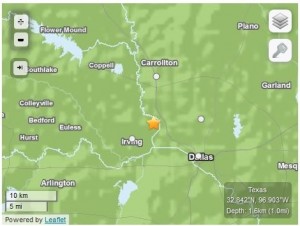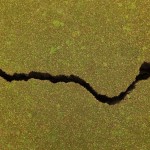Amid a New Swarm of Quakes, Researchers Head to Irving

Courtesy of USGS
This map from the USGS shows the approximate location of a recent quake near Irving, Texas.
Updated 1/6/14 with more comment from Railroad Commission and information on Tuesday January 6th earthquake.
A team of seismologists headed to the North Texas town of Irving Monday. Like some other Texas towns, Irving has experienced scores of small earthquakes lately, 20 since last September, including a magnitude 3.5 quake that struck on January 6th. And the city is hoping to figure out what’s behind the shaking.
The upsurge in quakes started in Texas around the time the oil and gas boom took hold several years ago. Residents in many parts of the state blame the them on wastewater disposal wells, where fluid byproducts of oil and gas drilling are pumped deep into the ground. Scientists have shown how injecting fluid into the ground can cause earthquakes.
After a spate of quakes in the North Texas town of Azle, the Railroad Commission of Texas, the state’s oil and gas regulator, hired a seismologist, Dr. David Craig Pearson, and passed new regulations for disposal wells. The Commission says it is not investigating the Irving quakes.
“The Railroad Commission is not investigating seismic activity around Irving,” Ramona Nye, a spokesperson for the Commission wrote in an email to StateImpact Texas. “Specifically, there are no disposal wells in Dallas County, and there is only one natural gas well in the vicinity, and it is an inactive well.”
“The Railroad Commission is aware of these recent earthquakes in the Irving area, and Dr. Pearson has put SMU researchers in contact with City of Carrollton personnel so that SMU researchers can install a seismometer in the area to further pinpoint the locations of these seismic events,” Nye wrote.
Scott Hudson, the Environmental Services Director of Carrollton, said to his knowledge no one from that city had been in touch with the Railroad Commission. But Chris Hillman, the City Manager of Irving said his city had “reached out” to the Commission and that SMU researchers will travel to Irving today to install the monitor.
“As we learn and understand more about these issues, we’ll continue to pass along more information to our residents,” says Hillman.
Ms. Nye said the Commission’s Seismologist Dr. Pearson was not available for an interview.
In a statement emailed to StateImpact Texas, Prof. Brian Stump SMU’s Chair of Geological Sciences, says installing the monitor will help researchers understand what’s happening under Irving.
“Pinpointing the exact location of the earthquakes is dependent on local seismometers and thus the first step in understanding the nature of the seismic activity,” wrote Stump. “The team will continue to interact with local officials about the seismic events.”


